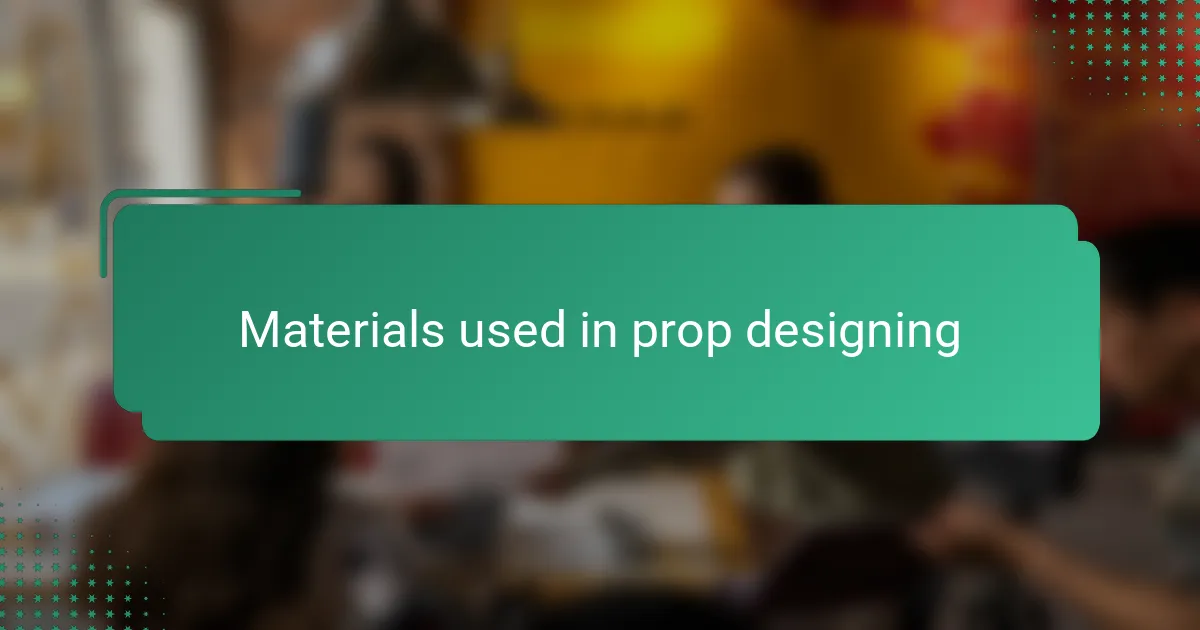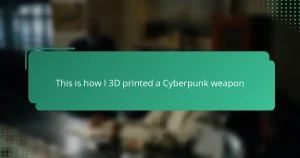Key takeaways
- Science fiction props blend art and technology, enhancing the storytelling experience and immersing audiences in futuristic worlds.
- Material selection is crucial in prop design; lightweight yet durable materials like EVA foam and various plastics create aesthetically pleasing and functional pieces.
- Precision tools and techniques, such as heat shaping and careful assembly, are essential for crafting realistic and cohesive props.
- Detailing and finishing techniques, including layering paint and clear coats, enhance the realism and durability of props, making them visually compelling and long-lasting.

Understanding science fiction props
Science fiction props aren’t just objects; they are storytellers in their own right. When I first handled a replica helmet from a classic sci-fi series, I realized how much thought goes into making these pieces believable and immersive. Have you ever noticed how a simple prop can instantly transport you into a futuristic world?
Creating or studying these props requires understanding the blend of art and technology behind them. It’s not just about aesthetics but also about functionality—how to make something look advanced yet plausible. From my experience, this delicate balance is what makes science fiction helmets so captivating.
I often wonder what emotions designers aim to evoke through these items. Is it awe, curiosity, or a sense of adventure? For me, exploring these props feels like stepping into the minds of creators who dreamed of worlds beyond our own, sparking my own imagination along the way.

Materials used in prop designing
When I set out to design the Halo helmet, choosing the right materials felt like laying the foundation for the entire project. I wanted something sturdy but not too heavy—something that could hold up under close scrutiny but still feel wearable. That’s why I leaned heavily on high-density EVA foam; it’s lightweight, easy to shape, and surprisingly durable for a prop.
Have you ever picked up a piece of plastic and been surprised by how much personality it can have? I used several types of plastics, including acrylic and ABS sheets, to add those crisp lines and futuristic accents. They offer sharp detail that foam alone just can’t achieve, and when painted right, they bring an almost metallic sheen that instantly sells the sci-fi vibe.
One thing I learned is that the tactile quality of materials matters just as much as the visual impact. For example, I added subtle latex detailing to replicate wear and tear, creating a more lived-in feel. This attention to texture invites you to believe this helmet has seen battles, adventures, and stories beyond the screen. Isn’t that what good props should do—make you feel connected to a world that’s just out of reach?

Tools for prop creation
Diving into the tools I used for crafting my Halo helmet, I quickly realized that having the right equipment can make or break the entire process. For cutting the EVA foam, a sharp utility knife was my trusty companion—I learned the hard way that a dull blade just leads to sloppy edges and frustration. Have you ever struggled to cut through thick foam only to end up with ragged pieces? That experience taught me the value of investing in quality blades and maintaining them carefully.
Beyond cutting, shaping the foam required heat tools like a heat gun to gently mold curves and angles. I found that controlling the temperature was an art in itself—too hot, and the foam warps; too cold, and it remains stiff and uncooperative. This delicate dance between heat and form felt almost like breathing life into an inanimate material, which was incredibly satisfying. What’s your own go-to method for shaping tricky materials?
When it came to assembling parts, I relied heavily on contact cement and hot glue. Each adhesive brought its strengths: the contact cement offered a strong, permanent bond where I needed durability, while hot glue allowed for quick fixes during the build. Experimenting with these adhesives taught me how much patience and precision go into holding every piece just right. It’s a subtle reminder that even the smallest tools play a huge role in bringing sci-fi dreams to life.

Designing a Halo helmet concept
Designing a Halo helmet concept begins with immersing myself in the lore and visual language of the game. I constantly ask, how can I capture the helmet’s iconic silhouette while adding subtle personal touches? This challenge pushes me to rethink every line and curve, making sure each element feels authentic yet fresh.
Translating those ideas onto paper and then into 3D models takes both creativity and precision. I remember spending hours sketching different visor shapes, debating which would best reflect the Spartan’s futuristic toughness without losing approachability. Have you ever noticed how a tiny change in design can completely shift the character’s perceived personality?
What excites me most is balancing form with imagined function—how the helmet might protect or enhance a soldier in combat. I think about ventilation, HUD placement, and even weight distribution, even though it’s all fictional. Designing with that mindset breathes realism into a fantasy piece, making it feel like it truly belongs in the Halo universe.

Step by step Halo helmet build
Building the Halo helmet step by step felt like piecing together a complex puzzle where every part had to fit just right. I started by carefully cutting out the EVA foam templates, making sure each curve mirrored the iconic shape I had studied for hours. Have you ever felt that mix of excitement and tension while aligning pieces that are supposed to create something monumental? That’s exactly how it was as the helmet began to take shape.
Next came the heat gun—my little magic wand in shaping the foam. Gently warming the material allowed me to bend and mold the helmet’s sleek contours, but it was a delicate balance. Too much heat, and I risked warping the whole structure; too little, and the foam refused to curve. It’s almost like coaxing a shy character out of hiding, and that patient process taught me a lot about respecting the materials I work with.
Assembling the segments with contact cement and hot glue was where the vision became reality, but it also tested my precision and patience. There were moments I had to re-glue and realign edges, questioning if it would ever look seamless. Yet, when the helmet finally held together as a cohesive piece, there was this indescribable thrill—like touching a piece of the Halo universe with my own hands. Have you ever experienced that rush when something you imagined becomes tangible? It’s addictive.

Painting and detailing the helmet
Painting and detailing the helmet was where the project truly came to life for me. After priming the surface to ensure the paint would adhere smoothly, I carefully applied multiple thin layers of army green and metallic hues to capture the helmet’s worn, battle-hardened look. I remember spending hours blending subtle weathering effects—scratches, scorch marks, even tiny chips—that transformed a simple paint job into a story of countless conflicts.
What fascinates me most about detailing is how small touches can tell huge stories. Adding delicate silver dry brushing along edges suggested the steel beneath the paint, while stippling with darker tones gave the helmet that grime caught in crevices, making it feel like a relic rather than new merchandise. Have you ever noticed how these nuanced details invite you to imagine where the Spartan has been and what battles they’ve faced?
For the visor, I played with different translucent paints and clear coats to get just the right smoky reflectiveness. The final gloss finish not only protected the paint but also added that unmistakable sci-fi sheen. It’s incredible how these layering techniques, though painstaking, gave the helmet a believable, almost tactile presence—something I was proud to wear and display.

Tips for finishing and durability
When it comes to finishing a Halo helmet, I’ve found that layering clear coats is a game-changer for durability. After painting, sealing everything with several thin layers of polyurethane not only guards against scratches but also deepens the colors, making them pop under different lights. Have you ever noticed how a glossy finish can suddenly make a prop feel more real? That’s the subtle magic of good sealing.
Another trick I swear by is sanding between each paint or finish layer. It might sound tedious, but those smooth transitions prevent any chipping or peeling later on. I remember rushing through this step once and ended up with tiny cracks after just a few wears—it taught me to slow down and respect the process. Doesn’t it feel satisfying when patience pays off with a flawless surface?
For long-term durability, I also reinforce joints and vulnerable edges with flexible adhesives and a bit of extra foam inside. It’s like giving your helmet an internal skeleton that keeps it from warping or breaking when bumped. From my experience, it’s those behind-the-scenes reinforcements that make all the difference between a display piece and a wearable prop that lasts through conventions and cosplay adventures. Have you tried this approach yet? It really gave me peace of mind every time I wore my helmet out.


